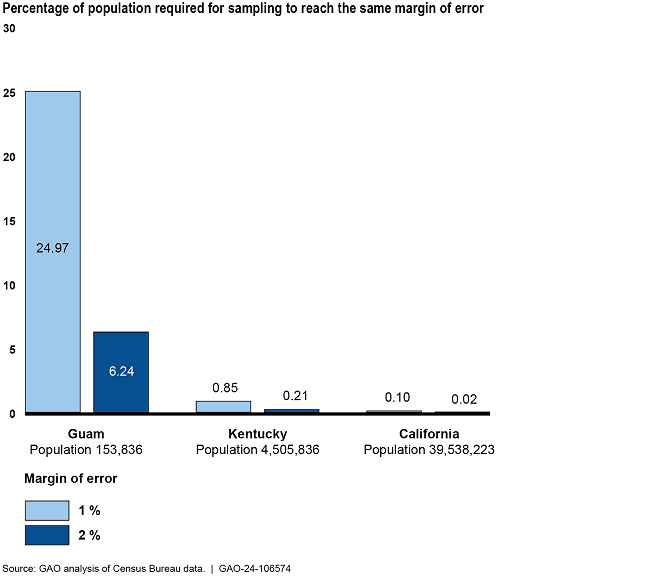U.S. Territories: Coordinated Federal Approach Needed to Better Address Data Gaps
Fast Facts
We testified about gaps in federal data for the U.S. territories—American Samoa, the Commonwealth of the Northern Mariana Islands, Guam, the Commonwealth of Puerto Rico, and the U.S. Virgin Islands. At each agency we reviewed, most statistical reports excluded at least one of the territories. Data gaps can limit the government's understanding of territory needs and how to best distribute resources.
A mix of cost, geography, and technical issues can cause data gaps. Efforts to address these issues have been uncoordinated.
We previously recommended that OMB develop a governmentwide approach for agencies to use to address these data gaps.
U.S. Territories

Highlights
What GAO Found
Federal statistical products often contain gaps in data for the U.S. territories of American Samoa, the Commonwealth of the Northern Mariana Islands (CNMI), Guam, the Commonwealth of Puerto Rico, and the U.S. Virgin Islands (USVI). For example, of the 52 statistical products reported to GAO by the National Agricultural Statistical Service, only one—the Census of Agriculture—includes the territories. Of the 21 products reported by the Bureau of Labor Statistics, none include American Samoa or CNMI, while Puerto Rico was included in the most—four. GAO also found that even when territories are included in federal statistical products, there may be disparities in the timeliness and in the measurement of quality of territorial data relative to the rest of the U.S.
Several factors contribute to the data gaps. Factors related to agencies' authorizing statutes, the cost of data collection, and territorial geography also contribute to data gaps. The figure below illustrates one such factor—namely that statistical products based on sampling of smaller jurisdictions have to sample much higher proportions of the population to achieve the same level of precision as sampling of larger populations.
Jurisdictions with Smaller Populations Need Relatively Larger Samples for the Same Margin of Error

Factors related to agencies' authorizing statutes, the cost of data collection, and territorial geography also contribute to data gaps. GAO also found that agencies generally have not conducted research on the costs, benefits, or feasibility of actions to increase the scope of federal statistical products to include the territories.
GAO found that territories have taken steps to mitigate federal data gaps. For example, officials from both American Samoa and USVI described local efforts to collect data equivalent to data collected by the Bureau of Labor Statistics and the Census Bureau, respectively. Officials from CNMI and Guam described efforts to update their address lists, while officials from Puerto Rico described local efforts to improve how their Gross Domestic Product is calculated.>
Statistical efforts are part of activities the Department of the Interior's Office of Insular Affairs funds through a technical assistance program for the territories. This program allocated a total of over $60 million from fiscal years 2019 through 2023.
The Office of Management and Budget (OMB) is responsible for coordinating the federal statistical system to ensure its effectiveness and efficiency. OMB budget documentation notes that as part of that role, the Office of the Chief Statistician identifies priorities for improving statistical programs and methodologies. However, there is not a coordinated, government-wide approach for agencies to use in deciding whether to collect data and report statistics from territories in federal statistical products. For example, OMB has not developed guidance or directives that explicitly address data collection in the territories.
Developing a coordinated, governmentwide approach for federal statistical agencies to use in examining and addressing territorial data gaps would improve the transparency of statistical decisions. Improved data collection for the territories could also better inform decision makers about how to allocate resources to the territories and how to evaluate the effectiveness of those investments.
Why GAO Did This Study
This testimony summarizes the information contained in GAO's May 2024 report, entitled U.S. Territories: Coordinated Federal Approach Needed to Better Address Data Gaps (GAO-24-106574).
For more information, contact Latesha Love-Grayer at (202) 512-4409 or lovegrayerl@gao.gov.
